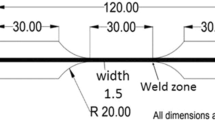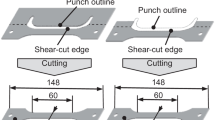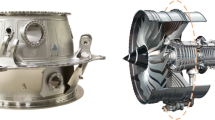Abstract
The increasing need for high strength complex hollow bodies for automotive application is pushing towards the use of sheet hydroforming techniques in conjunction with high strength steels. Unfortunately high strength steels are characterised by high springback levels. In this paper the springback and residual stresses have been analysed by means of laboratory trials carried out using the double sheet hydroforming technique. The attention has been focused on the upper blank of TRIP800 steel. The analysis has been performed using different approaches: i) characterisation of sample accuracy by means of a 3D coordinate measuring machine using a new proposed method based on the standard deviation calculation; ii) FE-analysis of both hydroforming and springback stages using an implicit FEM code; iii) residual stress evaluation by means of X-ray diffraction and laser cutting techniques. The effect of pressure, die insert geometry and friction at the blank holder on springback and residual stresses have been analysed and discussed in detail.
Similar content being viewed by others
Abbreviations
- T:
-
Top of the part
- R:
-
Corner radius of the part
- DMRS:
-
Difference between the inner and the outer mean residual stresses
- MeanRSin :
-
Inner mean residual stresses
- MeanRSout :
-
Outer mean residual stresses
- S1:
-
First set of experimental trials
- S2:
-
Second set of experimental trials
- FEC:
-
Free expansion at the corners
- CEC:
-
Constrained expansion at the corners
- ϕ and ψ:
-
Inclination of the sample for X-ray diffraction technique
- OP:
-
Overpressure evaluated from experimental curves
- ɛeq :
-
Equivalent plastic strain
References
Geiger M, Celeghini M (2002) Double sheet hydroforming of complex hollow bodies. Ann WPG IX/2:5–10
Geiger M, Celeghini M (2003) L’idroformatura delle Lamiere. Lamiera 3
Drewes E-J, Blümel K, Lenze F-J (2001) Tube and sheet hydroformed steel components for autobody application. La Revue de Métallurgie-CIT, October:927–935
Zhang SH (1999) Developments in hydroforming. J Mater Process Technol 91:236–244
Geiger M, Celeghini M (2002) Double sheet hydroforming of complex hollow parts. In: Proc 7th International Conference on Advanced Technology of Plasticity (ICTP) Yokohama, Japan 2:991–996
Vahl M, Bobbert S, Hein P (2000) Hydroforming of sheet metal pairs for the production of hollow bodies. La Revue de Métallurgie 97, October: 1255–1263
Verlinden B, Bocher Ph, Girault E, Aernoudt E (2001) Austenite texture and bainite/austenite orientation relationships in TRIP steel. Scripta Materiala 45:909–916
Graessel O, Krueger L, Frommeyer G, Meyer LW (2000) High strength Fe-Mn-(Al,Si) TRIP/TWIP steels development – properties – application. Int J Plastic 16:1391–1409
Pyshmintsev Yu I, De Meyer M, De Cooman BC, Savray RA, Shveykin VP, Vermeulen M (2002) The Influence of the stress state on the plasticity of transformation induced plasticity-aided steel. Metall Mater Trans 33A:1659–1667
Geiger M, Hein P (1999) Prediction and control of the draw-in of hydroformed sheet metal pairs. Prod Eng Ann WGP 1:33–38
Forcellese A, Fratini L, Gabrielli F, Micari F (1998) The evaluation of springback in 3D stamping and coining processes. J Mater Process Technol 80–81:108–112
Bruni C, Forcellese A, Gabrielli F, Troiani A (2003) Straightening of reinforced-concrete rods. In: Proc. of the 6th International Esaform Conference on Material Forming, Salerno, Italy, pp 95–98
Forcellese A, Fratini L, Gabrielli F, Micari F (1996) Computer aided engineering of the sheet bending process. J Mater Process Technol 60:225–232
Li KP, Carden WP, Wagoner RH (2002) Simulation of springback. Int J Mech Sci 44:103–122
Papeleux L, Ponthot J-P (2002) Finite element simulation of springback in sheet metal forming. J Mater Process Technol 125–126:785–791
Hino R, Goto Y, Shiraishi M (1999) Springback of sheet metal laminates subjected to stretch bending and the subsequent unbending. In: Proc 6th International Conference on Technology of Plasticity (ICTP), Nuremberg, Germany, pp 1077–1082
Samuel M (2000) Experimental and numerical prediction of springback and side wall curl in U-bendings of anisotropic sheet metals. J Mater Process Technol 105:382–393
Roll K, Rohleder M (2003) Simulation der Rückfederung in der Umformtechnik, Simulation in der Umformtechnik. Workshop, Stuttgart
Rohleder MW (2001) Simulation rückfederungsbedingter Formabweichunger im Productentstehungs prozess von Blechformteilen. Von der Fakultät Maschinenbau der universtität Dortmund zur Erlangung des Grades Doktor-Ingenieur genehmigte Dissertation, Dortmund
Carden WD, Geng LM, Matlock DK, Wagoner RH (2002) Measurement of springback. Int J Mech Sci 44:79–101
Asnafi N (2001) On springback of double-curved autobody panels. Int J Mech Sci 43:5–37
Yasar M (2004) Gas detonation forming process and modelling for efficient springback prediction. J Mater Process Technol 150:270–279
Palaniswamy H, Gracious N, Altan T (2004) Optimization of blank dimensions to reduce springback in the flexforming process. J Mater Process Technol 146:28–34
Prevéy PS (1996) Current applications of X-ray diffraction residual stress measurement. In: Vander Voort G, Friel J (eds) Developments in material characterization technologies. ASM International, Materials Park, OH, pp 103–110
He S, Van Bael A, Li SY, Van Houtte P, Mei F, Sarban A (2003) Residual stress determination in cold drawn steel wire by FEM simulation and X-ray diffraction. Mater Sci Eng A346:101–107
Smith DJ, Farrahi GH, Zhu WX, McMahon CA (2001) Obtaining multiaxial residual stress distribution from limited measurements. Mater Sci Eng A303:D281–D291
Albertini G, Bruno G, Dunn BD, Fiori F, Reimers W, Wright JS (1997) Comparative neutron and X-ray residual stress measurements on Al-2219 welded plate. Mater Sci Eng A224:157–165
Hauk V, Macherauch E (1982) Eigenspannungen und Lastspannungen. Carl Hanser, Verlag München Wien
Scholtes B (1991) Eigenspannungen in mechanisch randschichtverformten Werkstoffzuständen. DGM Informationsgesellschaft, Verlag, Oberursel
Kleiner M, Krux R, Homberg W (2004) Analysis of residual stresses in high-pressure sheet metal forming. Ann CIRP 53(1):211–214
Gnaeupel-Herold T, Prask HJ, Fields RJ, Foecke TJ, Cedric Xia Z, Lienert U (2004) A synchrotron study of residual stresses in a Al6022 deep drawn cup. Mater Sci Eng A366:104–113
Koç M, Altan T (2002) Prediction of forming limits and parameters in the tube hydroforming process. Int J Mach Tool Manuf 42:123–138
Blackwell D (1969) Basic statistics. McGraw-Hill, New York
Tolazzi M, Vahl M, Geiger M (2003) Determination of friction coefficients for the finite element analysis of double sheet hydroforming with a modified cup test. In: Proc. 6th International Esaform Conference on Material Forming, Salerno, Italy, 479–482
Author information
Authors and Affiliations
Corresponding author
Rights and permissions
About this article
Cite this article
Bruni, C., Celeghini, M., Geiger, M. et al. A study of techniques in the evaluation of springback and residual stress in hydroforming. Int J Adv Manuf Technol 33, 929–939 (2007). https://doi.org/10.1007/s00170-006-0539-x
Received:
Accepted:
Published:
Issue Date:
DOI: https://doi.org/10.1007/s00170-006-0539-x




